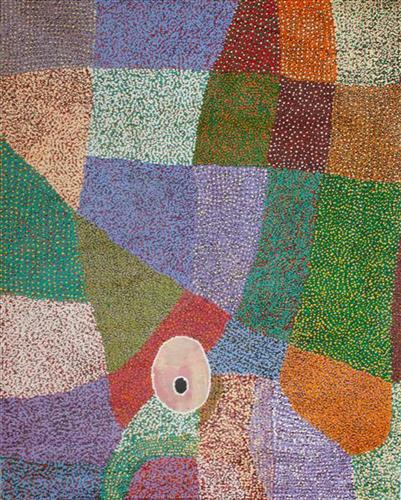Biography:
"I was born in Broome, grew up in Bidyadanga.
Kulyakartu is my grandmother’s Country… my mother’s mum and her family. I first went there to visit when our family got the Native Title for that country. It felt like home when I went there, I didn't want to leave that place.
I first started painting when I visited Parnngurr and stayed there for a little while in 2021. Being out there made we want to start.
All the grandparents, old people were painting. I would sit down and watch them paint. I was thinking that I could do painting like them. I paint mainly Country- desert area, Kulyakartu."
- Wilson Junior Mandijalu
Wilson Mandijalu was born in Broome, located along the Western Australian Kimberley coastline, though he has lived most of his life in the nearby Bidyadanga community. The name “Bidyadanga” derives from pijarta/ bidyada, meaning emu watering hole. It is here that the Great Sandy Desert meets the sea. Today Mandijalu continues to travel and paint principally between Bidyadanga and Halls Creek, spanning approximately 800 kilometres eastward.
Mandijalu is a Martu man, connected to the diaspora that relocated to Bidyadanga between the 1960s and 70s. At this time a prolonged drought was impacting the underground water systems that had sustained pujimanpa (traditional, desert dwellers) for millennia. His ancestors were compelled to leave their ngurra (home Country, camp); the flat grassland region of Kulyakartu, near the Percival Lakes in the Great Sandy Desert of Western Australia. While Mandijalu’s grandmother relocated northwest to the saltwater Country of Bidyadanga, two of her brothers and a sister (Muuki Taylor, Wokka Taylor (dec.), and Nyalangka Nola Taylor) journeyed further southward to Jigalong before eventually settling in Parnngurr community. These three individuals would go on to become significant cultural leaders, as well as key members of the Martumili Artists group.
Although Bidyadanga has its own thriving artist collective, Mandijalu explains that his artistic journey was sparked during an extended visit to Parngurr. It was here, in the company of his extended family, that he began creating representations of his ancestral Country, Kulyakartu.
Mandijalu’s profound connection to painting is palpable in his work, as evidenced by his bold and playful colour palettes, striking compositions, and his exploration of the textural qualities of paint. Collectively these characteristics mark an artist of natural talent, belying Mandijalu’s relatively recent entry in the art world.




